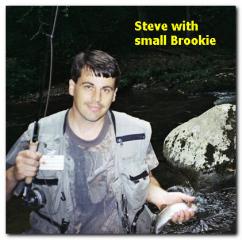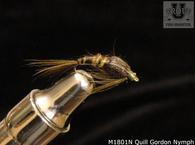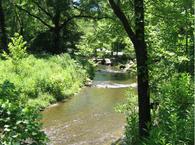
This course is meant as addendum to the previous class. In this class, the student will learn a novel approach to fishing the stuborn streams that can be found in the mountains of the South. It combines both fly fishing and in-line spinner fishing. After the completion of this course, the student will have an approach that affords a good opportunity for a father and son team.
We, Steve and Jerry,have fished the mountain streams together for many years and quite often the streams would be under a canopy of rhodendron branches, or other obstacles, that made it extremely difficult to spot the trout. Below is a description of a method for locating the trout and coaxing them into hitting a fly.
As we approached a stream with cascading pools, we would alternate by assigning a pool to the fly fishing technique or we would assign the pool to the spinner fishing technique. However, If we observed a trout near the end of the pool we would assign that pool to the fly fisher. When no trout was observed, whoever had that assigned pool, either fly fisher or spinner fisher, would utilize the blind fishing approach. We would search the water by simply blind casting the dry flies, such as terrestrials. over the water hoping to get a hit. The first few casts would be to the tail of the pool. ( Usually brook trout could be found there.) If those casts did not yield a hit the next series of casts would be toward the bank or shady spot in the pool, hoping to get a hit possibly from a brown trout lying there waiting to ambush some food. The next casts would be to the rapid highly oxygenated head water at the pool inlet, where we might expect to find a rainbow trout. The flies necessarily had to just happen to land ahead of the trout and not too far to the right or to the left. When blind fishing the odds of that happening can not be expected to be high so this method often proved to be unproductive.
The spinner fisherman, using in-line spinners such as Rooster Tails or Mepps, would use the same approach of blind fishing. The trout would often follow the spinner to the outflow of the pool, but would not hit it. A second and a third attempt for the same trout would often result in less interest with each subsequent cast. After a series of casts the trout would be sufficiently spooked and "headed for Dixie".
We quickly realized what was happening and decided that perhaps a team approach would be more productive. Now, when we approach a pool and do not observe any trout we both work that pool. First, the in-line spinner fisherman will cast his lure into the headwaters at the front of the pool. Quite often there would be a rainbow trout lying there enjoying the highly oxygenated waters, and waiting for the current to bring it a morsel of food such as a minnow. If the spinner appears to satisfy that desire we would have a trout on the line. However, if that cast was not sucessful the trout would follow the spinner and he might hit it before it could be reeled in completely. Now, more importantly, if the trout follows the spinner but does not hit the trout will leisurely head back up the pool, conserving energy and not wanting to risk any more energy in chasing that particular morsel. But, since the trout is now somewhat frusterated he can be coerced into getting a smaller meal with much less energy expended
Since the trout was moving our eyes have become focused on the trout and the trout can be seen easily. A trout that can be seen is, indeed, a vulnerable trout and can be caught with a dry fly. At this point the fly fisherman is ready to launch his dry fly to an area just ahead of and above the bewildered trout and this is a high percentage cast!
In the event that there was not a trout in the head waters that was interested, as the in-line spinner continues down the pool, it will cause more commotion in the water and it will attract trout, from a farther distance to seek it out. Trout lying along the banks will often catch up with the spinner and hit it. If they do not hit the spinner, at least the trout has been lured out into the open and now can be easy prey for the dry fly.
Since we have adopted the double team approach to fishing the smaller pools found in the Southeast we have improved our catch rate and we have continued to enjoy the fellowship of each other.
Make a father and son field trip to one of these locations or a similar location.
Try a rooster tail lure or other lure.
Maps and Streams in North Carolina.





